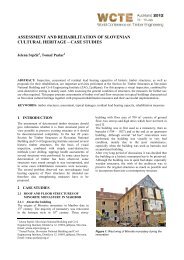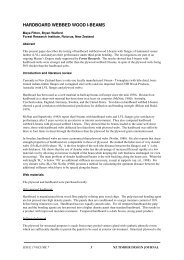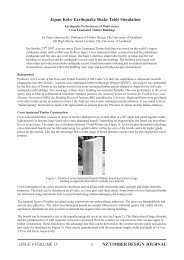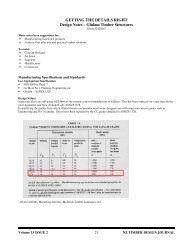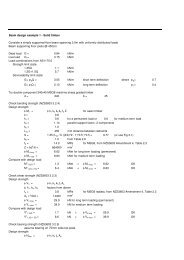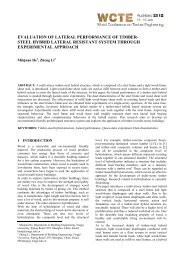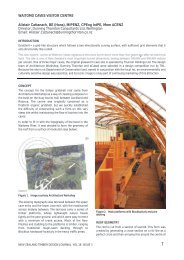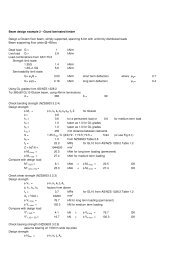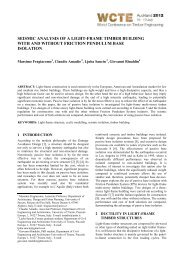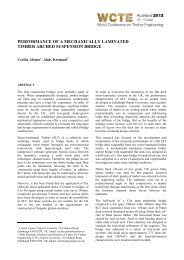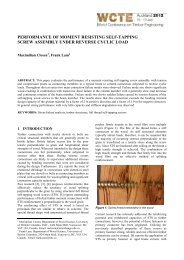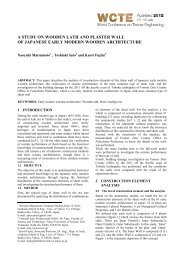00078 Lin Hu - Timber Design Society
00078 Lin Hu - Timber Design Society
00078 Lin Hu - Timber Design Society
Create successful ePaper yourself
Turn your PDF publications into a flip-book with our unique Google optimized e-Paper software.
3 RESULTS<br />
3.1 KEY CONSTRUCTION AND DESIGN<br />
PARAMETER<br />
Based on data analysis, it was found that the<br />
combination of fundamental natural frequency with 1 kN<br />
static deflection, or with acceleration, or with velocity<br />
was well correlated to human perception. It is<br />
understood that the fundamental natural frequency is<br />
mainly controlled by the longitudinal stiffness and the<br />
mass, while the 1 kN static deflection is determined by<br />
the entire stiffness of the CLT floor in both the<br />
longitudinal and lateral directions. The acceleration or<br />
velocity is determined by the excitation, the entire<br />
stiffness and by damping ratio. It has been wellrecognized<br />
that determining the damping ratio accurately<br />
and to a certain reliability level of is not easy.<br />
Reproducibility is another issue. Besides, damping is<br />
largely controlled by the floor constructions details such<br />
as the joints, connections, and support conditions, and<br />
the non-structural components such as potions, flooring,<br />
toppings, insulation materials, furniture, etc. Moreover,<br />
the modal test results showed that, for the bare CLT<br />
floors tested, the measured damping ratio did not vary<br />
from one assembly to another as it was quit constant<br />
with a value of around 1%.<br />
Based on the laboratory study results, it has been found<br />
that in meeting the safety requirements for the supports<br />
and joints, the vibration performance of CLT floors were<br />
largely controlled by the CLT stiffness along the<br />
longitudinal direction and by the mass. The type of joints<br />
between the CLT panels did not significantly affect the<br />
measured fundamental natural frequencies, the 1 kN<br />
static deflections, and the subjective ratings. Therefore,<br />
it was decided to use the stiffness in the longitudinal<br />
direction and the mass as the key parameters in the<br />
design method to control CLT floor vibrations through a<br />
combination of fundamental natural frequency and 1 kN<br />
static deflection.<br />
3.2 PROPOSED DESIGN METHOD<br />
The proposed design method to control CLT floor<br />
vibrations consists of a design criterion and the relevant<br />
equations to calculate the design parameters.<br />
3.2.1 Scope<br />
At this point, the scope of the proposed design method to<br />
control vibrations of CLT floors covers the following<br />
1. bare floors with finishing, partitions and<br />
furniture, but without heavy topping,<br />
2. vibrations-induced by normal walking,<br />
3. well-supported floors,<br />
4. well-jointed CLT panels, and<br />
5. inclusion of the self weight of CLT panels only<br />
(i.e. without live load).<br />
cover various types of toppings and ceilings, and other<br />
floor design options.<br />
3.2.2 Advantages<br />
The proposed design method is focused on target<br />
features, which include, among others<br />
1. simple for hand calculation,<br />
2. user-friendly,<br />
3. mechanics-based using the design values CLT<br />
panels available in producer’s specification,<br />
4. reliable to prevent CLT floors from excessive<br />
vibrations induced by normal walking.<br />
3.2.3 <strong>Design</strong> Criterion<br />
Based on the understanding of the fundamentals of floor<br />
vibrations and the special features of CLT floor<br />
vibrations, and following the laboratory test results, a<br />
proposed simple design criterion using fundamental<br />
natural frequency and 1 kN static deflection of a simple<br />
1-m wide CLT panel as design parameters has been<br />
developed.<br />
The design criterion is expressed in Equation (1).<br />
f<br />
d<br />
<br />
0.7<br />
13.0<br />
Or<br />
1.43<br />
f<br />
d <br />
39<br />
where f = fundamental natural frequency calculated<br />
using Equation (2) in Hz, and d = 1 kN static deflection<br />
calculated using Equation (3) in mm.<br />
3.2.4 Equations to Calculate the <strong>Design</strong> Parameters<br />
f<br />
3.142<br />
2<br />
2l<br />
EI<br />
1m<br />
eff<br />
A<br />
(1)<br />
(2)<br />
where, f = fundamental natural frequency of 1m CLT<br />
panel simply supported in Hz, l= CLT floor span in m,<br />
EI 1<br />
m<br />
eff<br />
= effective apparent stiffness in the span direction<br />
which is published by the producers for 1m wide panel<br />
in N-m 2 , = density of CLT in kg/m 3 , and A = crosssection<br />
area of 1-m wide CLT panel, i.e. thickness*1m<br />
width in m 2 . The static deflection under 1 kN load can be<br />
calculated using Equation (3) below.<br />
3<br />
1000Pl<br />
(3)<br />
d<br />
1m<br />
48EI eff<br />
where, d = static deflection at mid-span of the 1m wide<br />
simply supported CLT panel under 1 kN load in mm,<br />
and P = 1000 N.<br />
However, because of the mechanics-based feature, it is<br />
possible to expand its scope to include other construction<br />
details. A study has been planned to extend the scope to



